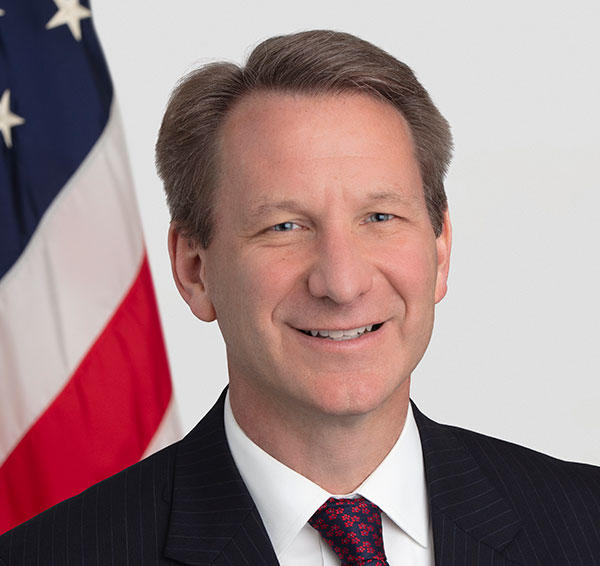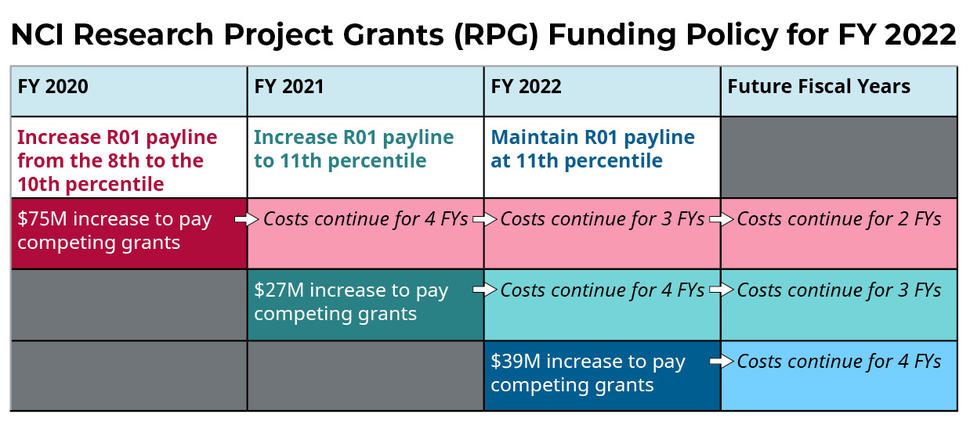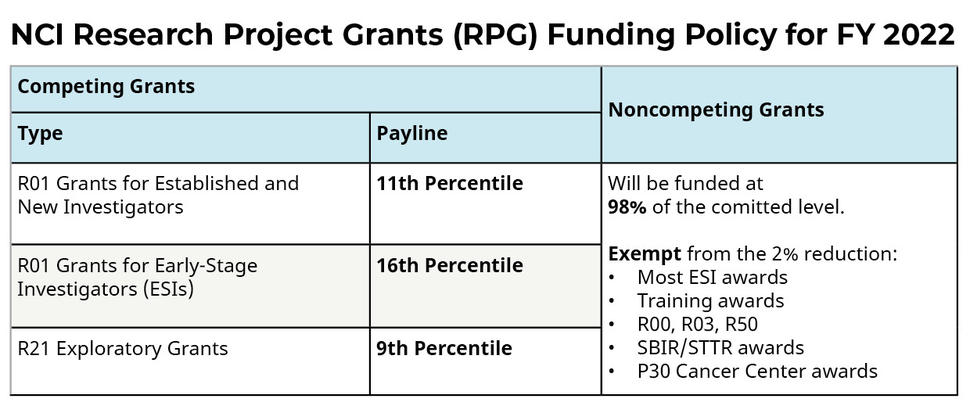Budget Increase Funds a Growing NCI Grants Portfolio
, by NCI Director Dr. Norman E. Sharpless
In this blog post, NCI Director Dr. Sharpless discusses what the $353 million increase for NCI’s budget in fiscal year 2022 means for grants paylines. Additionally, he expands on the financial challenges NCI faces despite the generous increase in funding.
On March 15, 2022, President Biden signed funding legislation for NCI, the National Institutes of Health, and other federal agencies. Although a new fiscal year begins each October 1, NCI has been operating under continuing resolutions that provided interim funding since October 1, 2021.
The legislation that reached the President’s desk was worth the wait. The government-wide appropriation bill contained a generous $353 million budget increase for NCI cancer research. Once again, Congress has demonstrated its enduring commitment to people with cancer and cancer science, a commitment that has contributed to three decades of steadily decreasing U.S. cancer mortality.
In December, as NCI waited to receive its final budget for fiscal year (FY) 2022, I reported on NCI interim grant paylines. While waiting for final action on a full-year budget, the most prudent approach was to adopt a conservative, provisional spending plan based on the interim grant paylines I announced in December. With action by Congress and the President, NCI now has a clear financial picture for the balance of FY 2022.
A $353 million budget increase is substantial. But any increase must be measured against ongoing financial commitments and rising costs at NCI. Like all institutions, including those where extramural grantees conduct their research, NCI makes commitments to long-term research that lead to future financial costs. Sustained progress in cancer research requires dedicated funding for sufficient years to allow researchers to test their hypotheses in an environment that fosters scientific creativity and yields results that improve lives. But these research commitments have inescapable budget implications.
NCI payline decisions, 2019–2021. As discussed below, the recent R01 payline increases that NCI approved offer a textbook example. Table 1 displays the future financial implications of NCI decisions to raise the R01 payline and commit funding to pay these awards.
In FY 2019, the R01 payline was at the 8th percentile. By FY 2021, NCI had raised the R01 payline to the 11th percentile, an increase of 37%. Because nearly all R01 grants are 5-year awards, when NCI pays additional grants by raising this key payline, each percentile increase imposes costs for 4 more years after the initial award, as Table 1 illustrates.
As you can see, when NCI increases funding year after year for competing grants like R01s, the future costs of prior year funding decisions steadily mount, and the challenges of affording further payline increases become apparent.
Other factors compound the problem illustrated in Table 1. To issue new awards, NCI relies on the funding that becomes available as older grants expire – for example, as a grant reaches the end of its 5-year cycle. We reinvest these funds to pay a new round of grants. However, in each new year, NCI strives to issue a larger volume of grants than we did 5 years ago. This means the funding available from the smaller number of expiring grants is insufficient to pay the larger number of grants we plan to issue each new year. This dynamic imposes a constant financial pressure on the NCI grants budget.
Inflation, which amounts to about 3% per year for biomedical research, further compounds this problem. At 3% per year, the cost of the new awards we plan to issue is about 15% higher than the average cost of the awards we issued 5 years ago. Thus, the dollars becoming available from expiring grants fall short of our financial needs due to inflation as well.
FY 2022 paylines and noncompeting awards. Turning to the specifics of NCI grants policies for FY 2022, the challenges I described lead to three difficult decisions.
The first is that after successive years of increasing the R01 payline, we cannot increase it further this year. This means holding at the 11th percentile, the same level as FY 2021. Certainly, this is better than the interim payline of the 9th percentile that NCI announced in December, but it’s not as generous as we would have liked. NCI is determined to further raise the R01 payline in the years ahead, but a pause at the 11th percentile is all that’s possible this year.
The second difficult decision involves noncompeting awards, which support years 2 through 5 of a typical 5-year grant. Here NCI must make a 2% cut, paying noncompeting awards at 98%. Since October, under the interim policy, NCI paid noncompeting grants at 90%. So, although the final outcome is 8% better, it’s not the full 100% level we had hoped for.
I summarized these grants policies and provided other details in Table 2, which I presented to the Board of Scientific Advisors on March 28. The two decisions are inextricably linked. We can afford the 11th percentile because of the reduction to noncompeting awards, and committing to a payline beyond the 11th percentile would have required unacceptably deep cuts to noncompeting grants.
The third difficult decision relates to other NCI programs. NCI is making cuts internally to our divisions, offices, and centers. To achieve our goals in this year’s budget environment, it’s important that there be shared sacrifice across NCI to achieve essential research priorities, which is why we are also imposing a 2% cut to internal programs at NCI.
NCI prioritizes grants funding. It’s also useful to consider a historical perspective on NCI budgets and grant funding. Since 2019, Congress increased the NCI budget by 13%. During the same period, NCI increased funding for competing grants by 27%, more than twice the rate of the overall increase. This demonstrates NCI’s deep commitment to funding our grants portfolio. To offer another example, Congress identified $150 million of the overall FY 2022 increase to support extramural grants. NCI expects to exceed the $150 million target by at least $25 million.
This blog post highlights the most prominent FY 2022 grant funding decisions. You can also access our website, where you will find further details on NCI grant policies.
In closing, I sincerely appreciate the tireless efforts of the NCI grantee community as you work to advance cancer science and deliver important results for those diagnosed with cancer, those at risk of cancer, and the growing population of cancer survivors.
The bottom line: Despite a generous budget increase from Congress for FY 2022, the legacy of NCI raising paylines in recent years poses difficult financial challenges. In announcing grant policies for the year, NCI is carefully balancing two competing priorities—funding current grantees and ensuring that we also invest in new science by funding an adequate number of new research awards.


